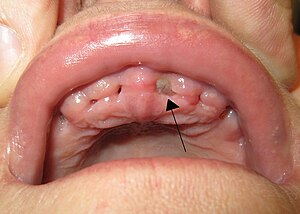Alveolar osteitis
| Alveolar osteitis | |
|---|---|
 |
|
| Alveolar osteitis of a socket after tooth extraction. Note lack of blood clot in socket and exposed alveolar bone. | |
| Classification and external resources | |
| Specialty | dentistry |
| ICD-10 | K10.3 |
Alveolar osteitis is inflammation of the alveolar bone (i.e., the alveolar process of the maxilla or mandible). Classically, this occurs as a postoperative complication of tooth extraction.
Alveolar osteitis usually occurs where the blood clot fails to form or is lost from the socket (i.e., the defect left in the gum when a tooth is taken out). This leaves an empty socket where bone is exposed to the oral cavity, causing a localized alveolar osteitis limited to the lamina dura (i.e., the bone which lines the socket). This specific type of alveolar osteitis is also known as dry socket or, less commonly, fibrinolytic alveolitis, and is associated with increased pain and delayed healing time.
Dry socket occurs in about 0.5–5% of routine dental extractions, and in about 25–30% of extractions of impacted mandibular third molars (wisdom teeth which are buried in the bone).
Since dry socket occurs exclusively following a dental extraction, it could be considered both a complication and an iatrogenic condition, but this does not take into account both the reason why the tooth required extraction (i.e., extraction may have been unavoidable due to significant pain and infection) and also the fact that many dry sockets are the result of poor compliance with postoperative instructions, notably refraining from smoking in the days immediately after the procedure.
Since alveolar osteitis is not primarily an infection, there is not usually any pyrexia (fever) and cervical lymphadenitis (swollen glands in the neck), and only minimal edema (swelling) and erythema (redness) is present in the soft tissues surrounding the socket.
...
Wikipedia
